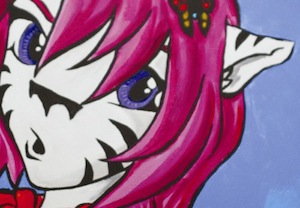New classes at the Wassenberg Art Center
By Hope Wallace

Would you like to learn to make art, or improve the art you do now? Did you ever wonder how the hilarious movies of Wallace and Gromit were created? Are you crazy for Japanese manga and anime comics? Would you like to learn how to oil paint, draw, or zing up your watercolors? Hey! We are an art center and we’ve got art!
The Wassenberg Art Center is now taking registrations for several new classes, listed below.
“Drawing in Your Right Mind,” a class for adults taught by Pat Rayman, will be presented on Tuesday evenings in September. This unique drawing class will help you train the right side of your brain, where artistic skills originate, and show you how to improve your drawing with observation and practice.
“Landscape Oil Painting with Sally Geething” for ages 10 to adult, will be held in late September and early October. You can choose between morning classes or afternoon classes. Participants will learn the basics of handling oil paints and creating a landscape.
“Watercolor and Mixed Media,” an adult class taught by Pat Rayman, will show participants how to combine different media with watercolors for exciting results. The class will be held on Tuesday evenings in October.
“Dynamic Acrylic Painting,” a class for adults instructed by Pat Rayman, will be held Tuesday evenings in November. You’ll learn how to use acrylic paint to create exciting artwork.
“Anime/Manga”, for ages 8 to adult, will show you the techniques and procedures associated with this popular art form. It will be held on four Saturday afternoons in September and October.
“Beginning Drawing,” for ages 10 and up (people younger than 10 may ask for authorization to take the class) is taught by Matt Temple. Learn the basics of drawing and how to use drawing tools. The class will be held in six evening sessions in October and November.
“Claymation,” for ages 6-8, will be held in two morning sessions in October and November. Matt Temple and Hope Wallace are the instructors. Learn how to make animated videos using clay characters.
“Medieval Multimedia,” with Valerie Parsel will be offered Saturday mornings, September 24 and October 1 from 10 to noon.
Initial Line Art, ceramics and potentially a beginning Photoshop class will also be on the horizon so stay tuned or better yet stop in or give us a call! Is there something you want to learn let us know. We will do our best to set something up.
Contact the art center at 419.238.6837 or wassenberg@embarqmail.com for further information or to register. Class size is limited, and preregistration is required. The Wassenberg Art Center is located at 643 S. Washington Street in Van Wert, Ohio.
Stylin’!
By Kay Sluterbeck
When people begin to make art, the first impulse is often to find the work of artists they like, and then try to paint like that artist. Some people never get past that stage; at any art show you can see work that emulates the work of well-known artists. But anyone who truly wants to be a serious artist will eventually wonder “What is MY style, and how do I find it?”
Some artists work out a technique and style that suits them, and then find subjects that work well with that style. Others begin with a subject they enjoy and then gradually find the techniques that express what they feel about it. But either way, the idea is to develop a way of painting that says what only YOU can say, and to paint what most appeals to you.
How does an artist know what’s right for him or her? It’s an evolutionary process. Artists paint differently at different stages of their life. Children begin by trying to draw the world as they see it. As they progress, they learn ways to make things look “real” on paper. Once they feel comfortable with drawing reality, they may experiment with fantasy drawing (princesses and castles, tanks and airplanes).
In high school, if they have a good art teacher, they will probably polish their realistic drawing and painting skills. If they go on to art school, they’ll have the chance to try nontraditional art forms such as abstraction and cubism. And at some point they will choose a path that most appeals to them. Artist Cathy Johnson did abstract paintings in art school because she enjoyed the visual impact and the tactile application of paint. But, she says, “After a while… my completely abstract works seemed like cop-outs…When I finished a painting, my overriding feeling was ‘what’s the point?’” She realized that what she really liked to draw and paint was the natural world — plants, animals, and the outdoors. She went on to become a successful fine artist, naturalist, art teacher and author of how-to art books.
There are ways to search for your own style. First, become aware of what you do. If your work pleases you, ask yourself why. Was it the technique, the subject, or the color that made you feel good about your work? Analyze your feelings and take notes if necessary.
Paint for yourself. Life is too short to spend time painting things that you don’t care about. If you’re concerned with painting subjects that “sell,” or using the colors that match peoples’ décor, your artwork will reflect your lack of emotional involvement. If you aren’t true to yourself and to your own inclinations, you won’t do your best work. It’s all right to take on the occasional commission, which is essentially a painting done to please someone else. But in your own day-to-day artwork, don’t think about selling or pleasing other people. No one else can say what you want to communicate about a subject, so use your art to say what is in your heart.
Painting like someone else will only stunt your growth. There was only one Andrew Wyeth, but too many people are turning out copies of his vision. His style reflects his knowledge of himself and his world. He painted what he cared about even when the critics disdained his work. Your slant on life is just as valid as his, so paint what YOU want to say.
When you look at the work of other artists, analyze what you respond to – or don’t respond to. Do you like the way Hopper used light in his paintings, or the way Rockwell painted familiar scenes of American life? Do you get excited over the colors and drips of a Pollock? Don’t try to copy their work, but remember what you liked and try to get that feeling into your own work.
Once you find your “style,” don’t get locked into it. Life involves change, and your style should also grow and change to reflect your changing vision of life. When something in your work no longer expresses what’s in your heart, search for a new way of doing it. Remember that safe art is boring art – for both the artist and the audience.
In short, paint the way you want to because it expresses the way you feel at this point in your life; it feels truthful to you; and it makes you happy.
POSTED: 08/24/11 at 1:02 pm. FILED UNDER: What's Up at Wassenberg?







